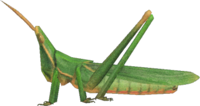Long locust
- "I caught a longheaded locust! Why the long head? (Face... Whatever.)" —Animal Crossing
- "I caught a long locust! Locust where? Here!" —Wild World
| ||||||
 | ||||||
| Real-world info | ||||||
|---|---|---|---|---|---|---|
| Name: Acrida cinerea Family: Acrididae | ||||||
| Main appearances | ||||||
|
| ||||||
| Other appearances | ||||||
Names in other languages
ショウリョウバッタ
中华剑角蝗 Acrida cinerea Langosta alargada Acrida cinerea Акрида
방아깨비 中華劍角蝗 Acrida cinerea Langosta alargada Nasenschrecke Veldsprinkhaan | ||||||
The Long Locust (ショウリョウバッタ, Shōryōbatta) is a green insect that can be seen and heard roaming the grass areas of town. It is naturally camouflaged by its green exterior and the green grass that surrounds it. Its location is found prior to hearing it close by. It can be found between August to November in Wild World, May to November in City Folk and New Leaf, and April to November in New Horizons, between 8 AM to 7 PM. If the player goes near it, the locust will travel away; if it goes to the water, it will disappear.
In the "Bugs and Fish" window in City Folk, it says "The name for this insect comes from its elongated head."
Catch details
In Animal Crossing
In Wild World
| 64px | ''The male makes a unique clicking sound in flight."
|
In City Folk
| Description | The name for this insect comes from its elongated head. |
|---|---|
| Time of year | All year |
| Time of day | All day |
| Peak times | Sep – Nov |
| Location | On the ground |
| Bug size | 73 mm |
| Rarity | Common |
| Selling price | |
| Furniture size |
New Leaf
| Time of year | May - Nov All year (Tortimer Island) |
|---|---|
| Time of day | 8 AM – 5 PM |
| Peak times | Sep - Nov |
| Location | On the ground (can be found on Tortimer Island) |
| Size | 60 mm |
| Rarity | Common |
| Selling price | |
| Furniture size |
In New Horizons
| Time of year | North: Apr – Nov South: Oct – May |
|---|---|
| Time of day | 8 AM – 7 PM |
| Location | On the ground |
| Weather | Any weather |
| Spawn requirement | Appears from the start of the game |
| Selling prices | |
| Furniture size |
Donating to the museum
As with all fish and insects in the Animal Crossing series, the Long Locust can be donated to the museum. Blathers the curator will say the following in the respected games.
In Animal Crossing
"I have a rather difficult time dealing with the soft underbellies of grasshoppers. They're...vulgar. And their legs! Why do they come off so easily when one merely handles the beast? Blech! Simply horrid!"
In Wild World
"I feel I must inform you the female long locust is much larger than the male. As such, I suspect this one you brought is, in fact, a female specimen. I don't mind telling you, it's not only bigger in size, but in wretchedness, wot? Then again, I suppose the males are quite wretched enough in their own right."
In City Folk
"Female long locusts are a great deal bigger than their male counterparts. Of course, gender aside, these locusts are large in general, hence the name. I must say, regular locusts are rather creepy enough. Being longer simply makes these ones even creepier."
The Long Locust appears in the first section of the exhibit, passed the butterflies and next to the small weed next to the pond.
In New Leaf
Upon being donated, the locust can be found in the first room of the bug exhibit jumping around near some bushes. The exhibit has this to say about the Long Locust:
"When male long locusts jump, you can hear the trademark stridulation noise they make. Long Locusts can be green as well as brown. The brown ones usually hide near dried grass or brown areas. While males are long, females are consistently much longer, making it simple to tell them apart. "
In New Horizons
"As if the average locust weren't large enough...we must suffer the long locust too! The wretched beasts are known for their unusually long hind legs as well as their elongated heads. But that is hardly the long locusts' worst trait... I tell you, they spit brown goo when they're scared! Revolting behavior indeed! Ugh and ewww!"
Real-world information
Acrida cinerea, also known as the Oriental longheaded grasshopper/locust or Chinese grasshopper, is a member of the grasshopper and locust suborder Caelifera. It is native to all the East Asian countries.
More information on this topic is available at Wikipedia.
Names in other languages
| ショウリョウバッタ shōryōbatta |
Acrida cinerea, lit. "Spirit locust" | |
| 방아깨비 bang-eokkaebi |
Acrida cinerea | |
| 中华剑角蝗 zhōnghuá jiànjiǎohuáng |
Lit. "Chinese grasshopper" | |
| 中華劍角蝗 Unknown |
||
| Акрида Akrida |
From genus name | |
| Veldsprinkhaan | Grasshopper | |
| Nasenschrecke | Portmanteau of Nase (nose) and Heuschrecke (locust). | |
| Langosta alargada | Lit. "Long grasshopper" | |
| Criquet Acrida cinerea (NH) |
Locust/cricket From scientific name | |
| Acrida cinerea | From scientific name | |
| Bugs | |||||||||||||||||||
|---|---|---|---|---|---|---|---|---|---|---|---|---|---|---|---|---|---|---|---|
| |||||||||||||||||||
| This article about a species is a stub. You can help Nookipedia by expanding it. |
Cite error: <ref> tags exist for a group named "nb", but no corresponding <references group="nb"/> tag was found